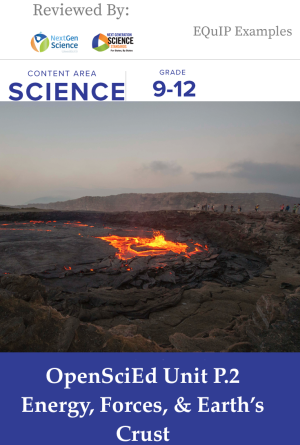
OpenSciEd is a nonprofit organization that brings together educators, philanthropic organizations, curriculum developers, and professional development providers to improve science education through the development and implementation of high-quality, freely available science instructional materials. The goal of OpenSciEd is to ensure that all educators, from elementary to high school, have access to a free, coherent, rigorous, research-based set of instructional materials that will support all students in meeting the vision for science literacy described in A Framework for K-12 Science Education and the Next Generation Science Standards.
Score: 8
Awarded the NGSS Design Badge
Science Discipline: Physical Science, Earth and Space Science
Length: Unit
Year Reviewed: 2023
This unit is anchored by a crack in Earth’s crust that appeared in the Afar region in 2005. Earthquakes and a volcanic eruption also occurred around this time. Students read about the Afar event and about other earthquakes that occur in North America. Students look for similarities and differences in these earthquake events, prompting students to model the events that occurred before, during, and after the crack was discovered. In Lesson Set 1 (Lessons 1-8) students figure out that changes in the structure of matter involve unbalanced forces and energy transfer, using this idea to explain earthquakes and volcanoes at plate boundaries. Students then investigate the structure and dynamics of Earth’s interior using tomography and modeling, including radioactivity, to explain the unbalanced forces driving changes in Earth’s crust. In Lesson Set 2 (Lessons 9-13) Students investigate the ages of rocks to understand the history and future of the Afar region. Students use a simulation to figure out the interactions happening at tectonic plate boundaries, and investigate the nature of the relationship between mass and forces on the movement of tectonic plates to explain the past, present, and potential future of the Afar region. Students apply these ideas in a final transfer task to explain why the Midcontinent Rift, a rift similar to the rift in the Afar region, failed to create an ocean in the middle of North America 1.1 billion years ago.
Link to Materials
The following link will direct you to the OpenSciEd Unit P.2 Energy, Forces, & Earth’s Crust unit page: P.2 Energy, Forces, & Earth’s Crust
NGSS Design Badge
Awarded: Nov 28, 2023
Awarded To: OpenSciEd Unit P.2 Energy, Forces, & Earth’s Crust
The NGSS Design Badge is awarded only to the version of this unit that was reviewed. If any modifications are made to this unit, the revised version cannot be promoted as having earned the badge.
 Reviews & Questions
Reviews & Questions
No comments submitted